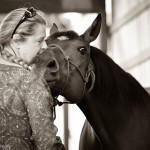Breast Cancer Society Posting
Breast Cancer: Emotional Healing with Horses
Aug 18, 2014 | Posted by BCS in The Breast Cancer Society website.
Posted in Coping Strategies, Finding Support, Health and Body
Horses have long played a role in human life. They’ve helped with farming; they’ve served in wars; they’re the stars of some of our favorite books and movies. They are endeared in our imaginations as symbols of freedom, power, strength and beauty.
But they’re far more than that. Scientific evidence is now illustrating just how impactful human-horse relationships are for healing purposes, not only contributing to emotional wellbeing, but also offering physical benefits to counteract radiation and chemotherapy side effects.
Consider, for instance, the many Wounded Warrior programs that employ equine therapy. Returning veterans suffering elevated heart rate and PTSD side effects have benefitted simply by standing next to horses, reporting feelings of calm, joy and peacefulness, which are long-lasting.
“Women recovering from breast cancer are wounded warriors themselves, essentially in a PTSD mode,” says Trish Broersma, founder of Riding Beyond, an Oregon-based equine therapy program for breast cancer survivors. “They’re recovering from a battle for their lives. Horses can provide them the same benefits as our veterans receive.” With more than 25 years of experience as therapeutic riding instructor and certified equine specialist, Broersma knows the heart of the horse. And it’s that giant heart – literally and spiritually – that is helping breast cancer survivors deal with the after-effects of surgery, chemotherapy and radiation.
Horses? Really? – Recent studies conducted by the Institute of HeartMath explain the bidirectional “healing” that happens when people are near horses. Explains Broersma, “The horse has a complex coherent heart rhythm with a large magnetic field.” It’s five times larger than a human’s and can directly influence a nearby person’s heart rhythm. The coherent heart rate pattern is associated with positive emotion found in the states of calm and joy. These research findings could account for the many physiological benefits people experience when they interact with horses: lowered heart rate and blood pressure; more beta-endorphins to suppress pain; less anger and hostility; decreased stress, tension and anxiety; and overall feelings of empowerment and trust.

Riding Beyond aims to address the ongoing issues that breast cancer patients often face after surgery, radiation and chemotherapy, including:
- Decreased self esteem
- Physical and emotional difficulties
- Impaired physiological functions, including digestion, respiration (shallow breathing) and rapid heart rate
- Tactile defensiveness: not enjoying touch or being touched
- A need to reconnect to the body and to others
- Physical weakness
Riding Beyond’s one-hour sessions over four weeks are offered on Broersma’s horse, Mystic (if participants are physically able) or alongside the horse. When lying on the back of a horse for 60 seconds or longer, face-down on the horse’s rump, part of the vagus nerve, which runs along the front of the body, is activated. In addition, the diaphragm and lungs experience a gentle compression. These two effects benefit the autonomic nervous system, so that digestion, respiration, heart rate and oxygen levels are often favorably impacted.
Broersma enhances the program with her own work in human development that draws on story, body-based modalities, current brain research, and cutting-edge human development practices enhanced by partnering with horses.
“I came to Riding Beyond with only the expectation that I would get to know a tiny bit about horses and maybe find some small happiness for the moment,” says breast cancer survivor Jan Lytjen. “Well, I was in for one of the most treasured and healing experiences I’ve had in this rocky road of life. This would be a healing of the heart.”
Finding a Horse Therapy Program – Broersma recommends seeking equine programs vetted by the Professional Association for Therapeutic Horsemanship (PATH International). Their website includes a searchable function to find PATH-certified centers closest to your home. And while Riding Beyond is one of only two facilities to focus on the physiological practice of lying backwards on a horse (Dream Rider Equestrian Therapy of California is the original program upon which Broersma based her own), she believes women can benefit from guided experiences around horses at other accredited programs that are oriented toward healing benefits.
“When evaluating local programs, it is helpful to ask if it is PATH-certified,” she says. “You can ask for referrals, and you can also ask if you can sit and observe a session.” The biggest concern, she says, is that the facility has safety practices in place that respect the participant and the sentient nature of the horse.
The Future – “There is currently no standard, ongoing medical rehabilitation to help women with the host of physical, emotional and spiritual issues they may face years after surgery,” says Broersma. “There needs to be more aware about this aspect of healing. I’d like to see medical teams share with patients the available resources that exist – like Riding Beyond and the myriad others – as the next step in the treatment plan. Because, as it turns out, science is proving that working with horses is not so outlandish and risky as it at first sounds.”
View the original posting at
http://www.breastcancersociety.org/2014/08/breast-cancer-emotional-healing-with-horses/
